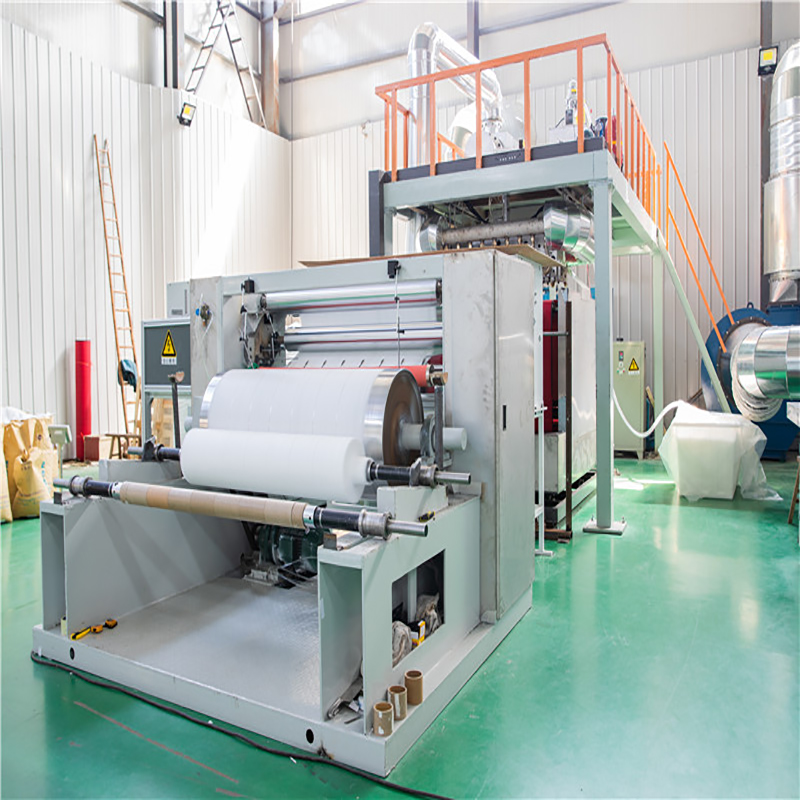Several common finishing processes can be used to enhance the properties of meltblown fabric. Here are some of them:
Heat Setting: Heat setting involves subjecting the meltblown fabric to controlled heat to stabilize its dimensions and improve its dimensional stability. This process helps reduce shrinkage and distortion and enhances the fabric’s strength and durability.
Calendaring: Calendaring is a process where the meltblown fabric is passed through heated rollers under pressure. This process can improve the fabric’s smoothness, surface appearance, and uniformity. It can also enhance fabric strength and density by compacting the fibers.
Lamination: Lamination involves bonding the meltblown fabric with another material using heat, pressure, or adhesives. This process can add additional properties to the fabric, such as water resistance, breathability, or barrier properties.
Coating: Coating is the application of a thin layer of chemicals or polymers onto the surface of the meltblown fabric. This process can impart specific properties to the fabric, such as water repellency, flame retardancy, antimicrobial properties, or improved printability.
Dyeing and Printing: Meltblown fabric can undergo dyeing or printing processes to add color or patterns. Dyeing involves immersing the fabric in a dye solution, while printing applies color or design using various printing techniques. These processes enhance the aesthetic appeal and customization options of the fabric.
Antistatic or Conductive Treatments: Meltblown fabric used in applications where static electricity buildup is a concern can undergo antistatic or conductive treatments. These treatments involve applying chemical additives or conducting fibers to the fabric to reduce or dissipate static charges.
Chemical Finishes: Chemical finishes can be applied to the meltblown fabric to improve its performance in specific applications. Examples include water repellency, oil repellency, stain resistance, flame retardancy, melt blown nonwoven fabric making machine or antimicrobial properties.
Ultraviolet (UV) Stabilization: If the meltblown fabric is intended for outdoor or UV-exposed applications, UV stabilization treatments can be applied to improve its resistance to UV degradation, prolonging its lifespan.
The choice of finishing processes depends on the desired properties and end-use requirements of the meltblown fabric. Manufacturers can select and combine these processes to tailor the fabric’s characteristics to meet specific application needs.
How does heat setting affect the dimensional stability of meltblown fabric?
Heat setting is a process used to improve the dimensional stability of meltblown fabric. Here’s how it affects the fabric’s dimensional stability:
Reduction of Shrinkage: Meltblown fabric consists of fine fibers that can be susceptible to shrinkage when exposed to heat or moisture. The heat setting process involves subjecting the fabric to controlled heat, which helps to stabilize the fabric’s dimensions. This reduces the potential for further shrinkage during subsequent use or washing.
Fiber Relaxation: During the heat setting process, the fabric is heated to a specific temperature below its melting point. At this temperature, the polymer fibers in the fabric undergo a process called fiber relaxation. Fiber relaxation allows the fibers to reorient and adjust their structure, reducing internal stresses within the fabric.
Improved Strength and Durability: Heat setting also enhances the fabric’s strength and durability. As the fabric is heated and cooled, the polymer chains within the fibers undergo cross-linking, creating stronger bonds. This improves the fabric’s resistance to stretching, tearing, and breaking, making it more robust and durable.
Dimensional Uniformity: Heat setting helps to achieve dimensional uniformity across the fabric. By subjecting the fabric to controlled heat and pressure, any unevenness or distortions in the fabric’s structure are minimized. This results in a more even and consistent fabric with improved dimensional stability.
Prevention of Creasing and Wrinkling: Heat setting can help reduce the tendency of meltblown fabric to crease or wrinkle. By stabilizing the fabric’s structure and reducing internal stresses, the fabric is less prone to creasing or developing permanent wrinkles when subjected to mechanical stress or folding.
Overall, heat setting is an important step in the manufacturing process of meltblown fabric as it helps to improve the dimensional stability, strength, durability, and appearance of the fabric. It ensures that the fabric maintains its intended dimensions and shape, even when subjected to various environmental conditions and mechanical stresses.
